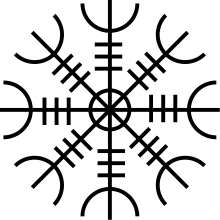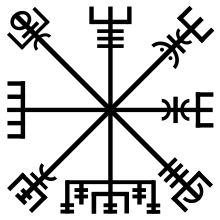Icelandic magical staves
Icelandic magical staves (sigils) are symbols called Galdrastafur in Icelandic, and are credited with magical effect preserved in various grimoires dating from the 17th century and later.[1] According to the Museum of Icelandic Sorcery and Witchcraft, the effects credited to most of the staves were very relevant to the average Icelanders of the time, who were mostly subsistence farmers and had to deal with harsh climatic conditions.[1]
Table of magical staves
| Icelandic name | Manuscript description | Image |
|---|---|---|
| Að unni | So a girl loves a man.[2] |  |
| Ægishjálmur | Helm of Awe (or Helm of Terror); to induce fear, protect the warrior, and prevail in battle. [3] |  |
| Angurgapi | Carved on the ends of barrels to prevent leaking. |  |
| Brýnslustafir | For use on whetstones. |  |
| Draumstafir | To dream of unfulfilled desires. |  |
| Dreprún | To kill an enemy's cattle.[4] |  |
| Feingur | A fertility rune. | |
| Gapaldur | Two staves, kept in the shoes, gapaldur under the heel of the right foot and ginfaxi under the toes of the left foot, to magically ensure victory in bouts of Icelandic wrestling (glíma). |  |
| Ginfaxi |  | |
| Hólastafur | To open hills. |  |
| Kaupaloki | To prosper in trade and business. |  |
| Lásabrjótur | To open a lock without a key. |  |
| Lukkustafir | Whoever carries this symbol with them encounters no evil, neither on the sea nor on the land.[5] |  |
| Máladeilan | To win in court.[6] |  |
| Nábrókarstafur | A stave used when making necropants (nábrók), a pair of trousers made from the skin of a dead man that are capable of producing an endless supply of money.[7] |  |
| Skelkunarstafur | To make your enemies afraid.[8] (A similar looking stave is titled Óttastafur in the Huld Manuscript.) | |
| Rosahringur minni | A lesser circle of protection. |  |
| Smjörhnútur | Butterknot, to ensure butter was procured through non-magical means. |  |
| Stafur gegn galdri | Staves against witchcraft.[9] |  |
| Stafur til að vekja upp draug | To invoke ghosts and evil spirits. |  |
| Þjófastafur | For use against thieves.[10] |  |
| Tóustefna | To ward off foxes.[11] | |
| Varnarstafur Valdemars | Valdemar's Protection Stave; increases favor and happiness. |  |
| Vatnahlífir | Protection against drowning. | |
| Vegvísir | To guide people through rough weather.[12] |  |
| Veiðistafur | For luck in fishing. |  |
Font
Following a visit to the Museum of Icelandic Sorcery and Witchcraft in the summer of 2006, Apostolos Syropoulos designed a font containing several of the magical staves.[13] This font is now included in the repositories of Fedora.[14]
See also
| Wikimedia Commons has media related to Icelandic magical staves. |
References
- 1 2 "Staves or magical signs"
- ↑ Lbs 4375 8vo, Iceland, 1900-1949 in the National Library in Reykjavík
- ↑ McCoy, Daniel. "The Helm Of Awe". Norse Mythology for Smart People. Retrieved 2 June 2017.
- ↑ From a 17th-century grimoire, in the Antikvarisk-Topografiska Arkivet in Stockholm.
- ↑ Huld Manuscript ÍB 383 4] in the National Library in Reykjavík
- ↑ From a 19th-century manuscript, lbs 4375 8vo, in the National Library in Reykjavík.
- ↑ http://www.galdrasyning.is/index.php?option=com_content&task=view&id=212&Itemid=60
- ↑ From Skuggi. Ársritið Jólagjöfin 4. Ár. 1940. "GALDRA-SKRÆÐA" by Jochum M. Eggertson
- ↑ From a 17th-century manuscript, lbs 143 8vo, in the National Library in Reykjavík.
- ↑ From a 17th-century medical text, am 434a 12mo, in the Arnemagnean Collection in Reykjavík.
- ↑ From a 19th-century manuscript, lbs 4375 8vo, in the National Library in Reykjavík.
- ↑ Huld Manuscript ÍB 383 4 in the National Library in Reykjavík
- ↑ "Magical fonts for the museum"
- ↑ "RPM resource icelandic-fonts". rpmfind.net. Retrieved 8 December 2014.
External links
This article is issued from
Wikipedia.
The text is licensed under Creative Commons - Attribution - Sharealike.
Additional terms may apply for the media files.